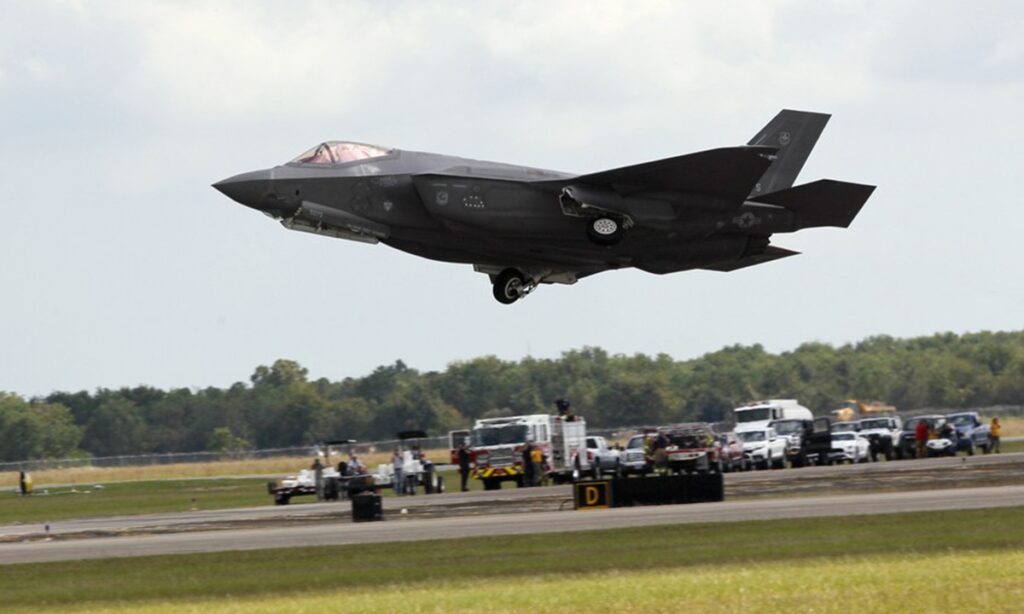Debris from the F-35B that went missing over South Carolina on September 17 was found in Williamsburg County, South Carolina, about two hours northeast of Joint Base Charleston on Monday following more than a day of frantic searching by the military. An as yet unspecified “mishap” was blamed for the accident. The pilot escaped unscathed.
“The mishap is currently under investigation, and we are unable to provide additional details to preserve the integrity of the investigative process,” the Marine Corps said in a statement Monday. The Marines ordered a two-day global pause in all aerial operations, with the errant F-35B becoming the third major aviation-related accident suffered by the military branch in less than two months.
Air units will be discussing “fundamentals of safe flight operations, ground safety, maintenance and flight procedures, and maintaining combat readiness,” the Marine Corps said.
How Many F-35s Have Been Lost?
Since it started being introduced into service with the Marines (2015), the US Air Force (2016), and the US Navy (2019) and began to be exported to foreign clients (starting with Israel in 2018), the F-35 has gained an unenviable reputation of being a costly, buggy, and crash-prone jet, with the F-35B that went down over South Carolina last week being at least the 11th Lightning II lost since 2018.
On September 28, 2018, a US Marine Corps F-35B crashed during a flight near Marine Corps Air Station Beaufort in South Carolina, with a faulty fuel tube blamed for the incident. The pilot emerged unscathed.
On April 9, 2019, a Japanese Self- Defense Force F-35A went down off Honshu, Japan. The pilot was killed after losing his bearings and suffering “special disorientation” mid-flight over the ocean.
On May 19, 2020, a US Air Force F-35A from the 58th Fighter Squadron crashed while performing a landing at Eglin Air Force Base in western Florida. Pilot error (trying to land at excessive speed) and a mechanical defect related to a flight control glitch that left the plane’s tail unresponsive were blamed. The pilot survived.
On September 29, 2020, a US Marine Corps F-35B was lost over Imperial County, California after colliding with a KC-130 tanker during midflight refueling. The tanker crew managed to bring their aircraft down for a hard landing. The F-35 pilot ejected successfully.
On November 17, 2021, a British Royal Air Force F-35B plunged into the Mediterranean Sea after its pilot ejected during routine operations. That crash was ultimately blamed on a protective cover getting wedged into the plane’s engine intake.
On January 4, 2022, a South Korean Air Force F-35A suffering from issues with its onboard avionics carried out an emergency belly landing. Investigators blamed a bird striking the warplane’s landing gear mid-flight. The pilot emerged unharmed.
On January 24, 2022, a US Navy F-35C plunged into the South China Sea after making a hard landing on the USS Carl Vinson super carrier. The pilot and six sailors on the deck of the aircraft carrier were injured. A Navy investigation attributed the incident to pilot error.
On October 19, 2022, another F-35, this one from the US Air Force, crashed at Hill Air Force Base in Utah during a training mission. The pilot ejected safely. It was later determined that turbulent air somehow confused the jet’s onboard avionics to the point where the aircraft became uncontrollable.
On December 1, 2022, a Marine Corps F-35B collapsed on a military base in Japan after suffering a landing gear failure during training. No one was injured.
Finally, on December 15, 2022, a US Navy F-35B crashed while attempting to perform a vertical landing at Naval Air Station Joint Reserve Base Fort Worth in Texas during testing of the jet’s systems. A “harmonic resonance” issue related to the jet’s Pratt & Whitney F135 engine was blamed, with the Pentagon halting further F-35 deliveries by Lockheed until an investigation was concluded.
What’s Wrong With the F-35?
Nearly 17 years after the F-35’s first flight, and eight years after its adoption into service, the F-35 continues to maintain a troublingly long list of technical bugs affecting both hardware and software. The aircraft, which has an astronomical total estimated purchase and sustainment price tag of over $1.7 trillion, and a per-plane cost of $70-$90 million, has faced years of harsh criticism from US officials, including former President Donald Trump at one point, who said the jet’s costs had spiraled “out of control.”
At its heart, the F-35 is the product of an idea that metastasized in the Pentagon after the end of the Cold War, envisioning an all-in-one fighter platform which could be used by every branch of the military, equipped with vertical take-off and landing capability, and carry out a broad array of missions using a variety of onboard weapons. The do-it-all jet was supposed to replace nearly all of America’s fourth-gen fighter, strike, and ground attack aircraft, including the F-16 Falcon, the F/A-18 Hornet and Super Hornet, the AV-8B Harrier II, and others.
The jet features just a single onboard engine – the aforementioned Pratt & Whitney F135, with engine-related troubles not only regularly referred to by watchdogs as a “leading driver” of the F-35’s problems remaining “mission capable,” but also making its operation over enemy territory or over the sea risky, since if something goes wrong, the plane doesn’t have a backup engine to limp home with.
Throughout its production cycle, the F-35 Lightning II has suffered a dizzying and seemingly endless list of technical problems, from neck-snapping ejection seats to problems, ironically, while operating in stormy weather.
In its 2023 report, the congressional Government Accountability Office revealed that the F-35 program “continues to experience schedule delays, cost growth, and late deliveries,” with procurement costs jumping by $13.4 billion since 2019, and modernization behind schedule and over budget.
“As of January 2023, of the 821 open deficiencies, the program office characterized five of these as category 1 [i.e. critical issues which could jeopardize flight safety and security], and 816 as category 2, [i.e. those which could impede or constrain mission success].”
In all, between December 2006 and 2023, the GAO has reported a whopping 277 category 1 and 2,467 category 2 deficiencies with the aircraft, among them serious issues like cabin over-pressurization, problems with the jets’ night vision systems, software bugs, radar issues, corrosion, ejection seats which could snap pilots’ necks, etc.
Is a Culture of Largess to Blame?
Sunday’s accident in South Carolina is the latest piece of F-35-related bad news for Lockheed Martin. In June, it was reported that the Pentagon had halted the delivery of any additional upgraded F-35s until major issues related to new Technology Refresh 3 (TR-3) hardware and weapons-related software were resolved. DoD F-35 program director Mike Schmidt told Congress in March that the risk assessment related to the TR-3 hardware upgrade wouldn’t be finished until April 2024.
Despite the delays and array of technical problems, the weapons giant has continued to rack up generous contracts related to F-35 procurement and production. For example, in July, the US Navy ordered a $490 million package of equipment from Lockheed “to procure various material mod kits, special test/tooling equipment, as well as…product engineering” for already delivered, but defective planes. In August, Lockheed received another $606 million “fixed-price incentive (firm-target) undefinitized” contract “for long lead time materials, parts, components, and efforts to support of maintaining on-time production and delivery of 173 Lot 19 F-35 Joint Strike Fighter aircraft for Foreign Military Sales (FMS) customers and non-US Department of Defense (DOD) participants.”
The terms of the contracts seem to be the culprit behind the F-35’s soaring costs (and Lockheed’s soaring profits, despite delivery of defective products), with so-called “cost-plus” and “undefinitized” contracts effectively making any overruns the buyer’s problem – i.e. that of US taxpayers, and of citizens of any country unfortunate enough to pen contracts for the planes from Lockheed.
What About America’s Competitors?
The worst part about the F-35’s troublesome history seems to be that the F-35 has already become “obsolete” in the sense that many of the US and NATO’s competitors have obtained the ability to defeat them, with Russia and China gaining capabilities to track and target the jets going back to the mid-to-late 2010s. In April, Iran announced that its engineers had created advanced radar technologies to not only detect F-35s, but identify the radar signature of individual F-35 planes, enabling the Islamic Republic to plan defensive operations accordingly.




